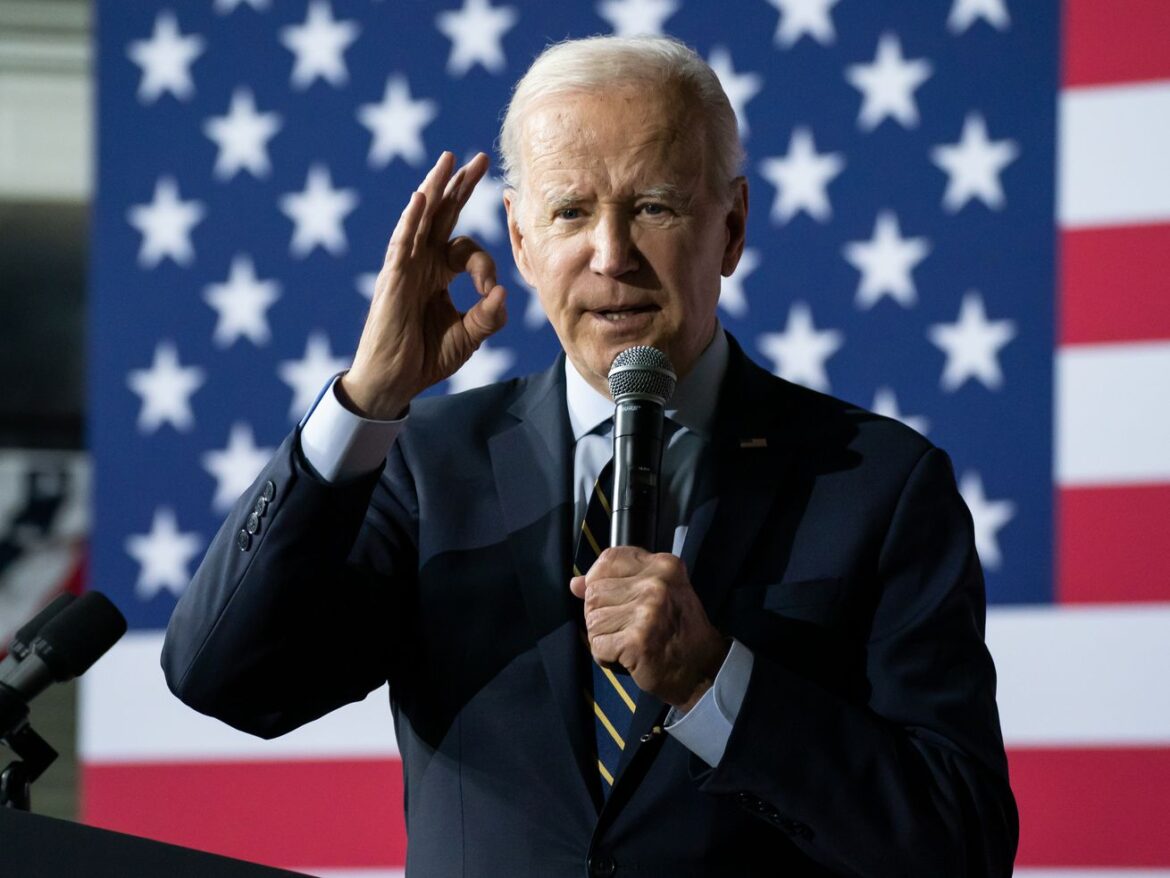Joe Biden is running for president in 2024. Here’s how his vision for the Democratic Party won.
President Joe Biden announced the long-expected today: He is running for a second term in office. Joined by Vice President Kamala Harris as his running mate, his fourth presidential campaign may be another unconventional and unorthodox campaign against former President Donald Trump — if Trump succeeds in beating a field of Republican challengers.
Biden and Harris’s announcement came in the form of a video posted Tuesday morning. “Personal freedom is fundamental to who we are as Americans. That’s been the work of my first term — to fight for our democracy, to protect our rights, to make sure that everyone in this country is treated equally, and that everyone is given a fair shot at making it,” Biden says, signaling what will be the key themes of their campaign: “The question we’re facing is whether in the years ahead, we have more freedom or less freedom, more rights or fewer.” Talking about his bipartisan accomplishments contrasts “extremist” Republicans with the Democrats trying to “protect” Americans, and pushing an optimistic forward-looking agenda.
Those messages hark back to the pitch Biden made four years ago, when his party was facing an identity crisis and competing theories for Democrats’ future. Since then, he has evolved as a Democrat — no longer the second coming of Franklin D. Roosevelt that he pitched himself as in 2020, nor the centrist who ran with Barack Obama in 2008, but a liberal incrementalist forced to work with the slimmest congressional mandate.
Biden and Harris are formally entering the fray with several big accomplishments — the Inflation Reduction Act was the single largest climate investment in history; the Bipartisan Infrastructure Act was the largest investment in bridges, trains, and internet access in at least a decade; and the CHIPS and Science Act pours historic sums into semiconductor and manufacturing jobs. Much better than expected midterm results last year breathed fresh air into the Biden presidency and set up House Republicans for a chaotic tenure with a tiny majority. Democratic control of the Senate has been a firewall against GOP legislation while still giving Biden opportunities to reshape the federal judiciary (albeit with exceptions). And the economy, which boasts the lowest unemployment rate in nearly 60 years, seems to be slowly stabilizing, after two years of persistently high inflation.
But Biden and Harris also face a plethora of obstacles. Both are unpopular: Only about 42 percent of Americans approve of Biden’s job performance, while around 40 percent approve of Harris, according to FiveThirtyEight polling averages. Seven in 10 Americans, including a majority of Democrats, do not want Biden to run for reelection, according to a recent NBC News poll. His age seems to be the primary reason they don’t want him to run again.
He still faces threats from Congress. His administration’s handling of the chaotic exit from Afghanistan is being investigated by congressional Republicans, along with scores of other things. But that probe poses a potential liability over the next year; it was around the time of the evacuation of the capital Kabul that Biden’s approval rating took a nosedive.
And the economy is still fragile, wrestling with still-high levels of inflation and interest rate hikes. There is still a chance of the country tipping into recession in the next year, which would complicate Biden’s optimistic campaign message.
Joe Biden’s vision of the Democratic Party
The divisions among Democrats and among American voters in general echo where the country — and the Democratic Party — was just four years ago.
When Biden announced his 2020 campaign in the spring of 2019, Democrats were in a moment of crisis. Republicans were united, and Donald Trump seemed to be cruising toward reelection. Polling seemed to show the same thing over and over: None of the dozens of Democrats running against Trump seemed like they’d be able to unite the base — or beat the incumbent. Electability ended up being the word of the day — and though he wasn’t the candidate of the future that many in the Democratic base wanted, Joe Biden seemed like the option most likely to win in a general election.
This time around, Biden is starting off as the default option. The party isn’t organizing primary debates or allowing room for a challenger, even though there doesn’t seem to be an obvious successor to the Biden presidency anyway.
But while his victory in 2020 proved that his party didn’t need to have the generational, ideological change some of his younger rivals demanded, his 2024 campaign will be imbued with lessons of the evolution of a moderate. As president, Biden has used the language of centrism and bipartisanship to evoke nostalgia and normalcy, while also pushing through monumental changes to the country — like his massive spending to support the economy during the pandemic, student loan cancellation, and the brief expansion of the social safety net through the American Rescue Plan. Republicans and centrist Democrats have criticized this before: that Biden and progressive Democrats have overpromised and tried to govern like they have overwhelming majorities.
That combination of nostalgia and future-focused optimism might make the 2024 campaign different from those Democrats have waged since 2016, even if Trump becomes the Republican nominee again. At least four Republicans — former South Carolina Gov. Nikki Haley, former Arkansas Gov. Asa Hutchinson, right-wing talk radio host Larry Elder, and conservative activist Vivek Ramaswamy — are already challenging Trump, while two more, South Carolina Sen. Tim Scott and former Vice President Mike Pence, are preparing to. And Trump’s disruptive energy will offer Biden another chance to contrast his message with one of Republican chaos. But for that to work, the American people need to know his record.
What the Biden campaign might look like
Biden’s campaign is expected to be all about contrast, Democratic strategists, pollsters, and fundraisers have told me. Instead of being a referendum on his first term, the Biden message will talk up optimism and accomplishments while letting Republicans confirm the “extremist” label they have ascribed to them.
Biden has plenty to use for that contrast. He’s consistently been on the road touting his infrastructure-related projects at ribbon cuttings for new projects, and his approval ratings have stabilized in the low 40s, about where Trump was at this point in his term. Biden has already been testing out varying 2024 rallying cries, from the midterms message of stopping “MAGA Republicans” and their “extreme ideology” to a forward-looking appeal for Democrats to “finish the job.” This also means we’ll see much more of Biden in the wild. His White House and his 2020 campaign have been tightly run with few leaks. His appearances are highly orchestrated, his off-the-cuff remarks limited, and his campaign stops in 2020 minimized during the pandemic.
In addresses since the midterms, he’s hinted at the parallel pitches he’ll make to the Democratic Party faithful and to the American people in general. To the base, the message is one reminding them of the danger he defeated once before: “We’re moving in the right direction. Now we’ve got to protect those gains … from the MAGA Republicans in the House of Representatives,” he said to union workers in Virginia in January. “I will not let it happen. Not on my watch.”
And in visits to states getting large federal investments from Biden bills, he’s offered a preview of the positive case he’ll make for supporting his agenda — protecting Social Security and Medicare, taxing the rich, reducing the cost of child care, and investing in manufacturing. He’s summed up his platform in a sentence: “We must be the nation we have always been at our best: optimistic, hopeful, [and] forward-looking.”
He’ll have help in getting this message off the ground this week: The Biden-aligned super PAC Unite the Country is launching a $1 million TV ad buy to run in battleground states soon after his official announcement.
All of this would be an evolution of the appeal to nostalgia and promise of stability that carried Biden through the 2020 election, a political year unlike the nation had seen.
Biden has learned lessons since his last campaign
Leading up to his expected entry into the Democratic primary field in 2020, Biden faced the very real prospect of being relegated to irrelevance as he faced a younger, more progressive, and historically diverse roster of candidates representing the future of his party.
The field of at least 20 contenders was the most diverse collection of presidential aspirants in history, made up of female, gay, Asian American, Black, and Latino candidates. All of them promised to be a new kind of Democrat, either more progressive and ideological than Biden or more energetic and better able to connect with the party’s base. Biden framed the election as a “battle for the soul” of America, and offered a taste of Obama-era nostalgia and a pledge to right the ship of state instead of the big, structural change people like Bernie Sanders, Elizabeth Warren, and Julián Castro were offering.
He also came with a lifetime of baggage: accusations of improper contact with women, an iffy record on race relations given his support for the 1994 crime bill and stance on mandatory busing in the 1970s, collaboration with racist Republican senators during his time in Congress, and concerns about his age.
But he knew how to play the game, betting big on the South Carolina primary, which he won and which pushed rivals out and helped him defy expectations to win the nomination. In the end, Democratic primary voters sided with Biden over any of the revolutionaries, disruptors, and innovators who competed against him.
During the 2020 campaign, the onset of the coronavirus pandemic and Trump’s handling of it would only boost Biden’s promise to make politics boring again and to not shy away from compromise. His winning pitch was essentially a call for change by restoring pre-Trump American politics.
In the end, he didn’t quite govern as he promised — his boldest proposals for protecting reproductive and voting rights and expanding the social safety net through the Build Back Better Plan died early on. But his brand of incrementalism actually hid massive change. His negotiations with Republicans produced once-in-a-generation bipartisan investments and reforms. And that has given him the ability to run a 2024 campaign that looks more like those run by his Democratic rivals back in 2020 than it does his last race.
The vindication of an incrementalist
Though he didn’t campaign as a revolutionary in 2020, Biden did offer a bold vision: an FDR-style presidency that would revolutionize social programs, reorder the economy, and address scores of progressive priorities, but dressed up in moderate rhetoric. Along the way, he managed to convince voters that an agenda and vision far more progressive than anything Barack Obama or Hillary Clinton ever pursued was actually fairly moderate.
“We’ve actually undergone incredible, fundamental legislative and structural change, and he speaks about it as if it were incrementalism,” María Teresa Kumar, the president and CEO of the activist group Voto Latino, told me. “Any one piece of legislation, the American Rescue Plan, the infrastructure act, the Inflation Reduction Act, any one of those, standing alone, would have been a signature piece of legislation under any presidency. And he has actually couched it in palatable ways so that it brings the country together.”
That laundry list of legislative accomplishments is evidence of his mastery of compromise, negotiation, and gradual progress, while also being proof to the left flank of his party that he can evolve. But it also demonstrates Biden’s politics, and his theory of government: that government can still be a force for good in Americans’ lives, even if it happens slowly.
“The president firmly believes that the government must be as good as the people it serves, and that means it has to listen, and pivot, and try to help people compromise, and abandon purity tests of all or nothing,” Allida Black, a University of Virginia historian, told me. “If there is one abiding principle of the Biden administration, it is that America is now the last best hope of making democracy work.”
The issue with Biden campaigning on his accomplishments is that not many people know about these laws — not what they do, how they affect everyday Americans, or what role Biden played in getting them done. Before the State of the Union, polling published by the Washington Post showed this conundrum: 62 percent of Americans thought the president hadn’t accomplished much or hadn’t accomplished anything. The same was true during the 2022 midterms and in post-election polling; while specific Democratic accomplishments or proposals were popular, not many Americans knew that those items were part of the Democratic platform.
Rashad Robinson, the president of the progressive advocacy group Color of Change, told me, “He should be playing up his accomplishments and playing up how we implement them, how we access them, how people can actually benefit from [things like] the Inflation Reduction Act and get the benefits from it.”
That kind of message will be especially important for shoring up the younger and college-educated voters who might not be as enthused with Biden’s candidacy but see no other options. In 2020, Biden was able to hold together much of the same coalition that gave Barack Obama two terms in the White House, despite Republican inroads among Latino voters and consolidation of white and rural voters.
Stopping Democratic slippage among Latino voters in key battleground states like Arizona, Nevada, and Georgia must again be a top priority. And the women, suburban voters, and political independents who continued to support Democrats in tight races last year will also be key to his success.
That support will require Biden to both contrast his agenda with whatever Republicans offer and offer a plan for the country that goes beyond running as the anti-Trump. Biden will have to make the election a choice between two competing visions instead of a referendum on his last four years, Dakota Hall, the executive director of the youth-voter-focused Alliance for Youth Action, told me.
“Biden should double down on a bold agenda and pitch the message that, ‘You know, I got this much with a split Senate. Imagine what I can do with a House that fully backs me and a Senate that fully backs me,’” Hall said.
Now Biden will have another chance to prove his understanding of the American electorate. He doesn’t have to win a primary fight to prove that his kind of incrementalism will work, but he does face the challenge of reminding Democrats, and the average American voter, what that incrementalism accomplished. And if Republicans offer up Trump again, that pitch might become even easier to make.



